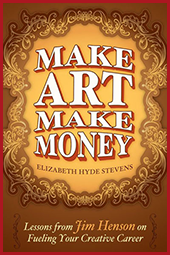Elizabeth Hyde Stevens 2013 ISBN 9781477817384
My attention was first drawn to this book when Mary Robinette Kowal mentioned on Writing Excuses that she had recently recorded the audiobook version. The idea sounded fascinating – an examination of how Jim Henson balanced the art side of his work against the business side of his work, and yet somehow managed to do the miraculous, and wildly succeed at both. So many artists feel that allowing any hint of money and commercialism into their work will destroy it. This often expresses itself in a sort of ‘well, we have a really fantastic production so we don’t need marketing’ attitude. And this often results in a production that fails before it even has a chance to draw breath. This book throws a splash of reality on vague anti-commercial resentment while fully embracing the idea that good art for good art’s sake is still the heartfelt desire of most artists. Make Art Make Money should be compulsory reading for every aspiring performer, actor, festival circuit artist and playwright.
Elizabeth Hyde Stevens is a great lover of the Muppets, and her love and attentiveness to the material glows through the pages. There is a strong feeling that Make Art Make Money is not so much a book, but rather a book-shaped love-letter to Henson and company. In preparation for this book, Elizabeth attempted to watch every last thing that Henson had ever made – even the clips made for sales meetings at IBM. Some of this material is extraordinarily difficult to get hold of. Some of it is extraordinarily expensive to get hold of. There is a serious dedication to the undertaking here, and the result is palpably more real, dimensional and insightful than would be any thin attempt at a characterisation of merely the artistic side of Jim Henson alone.
Where the book really comes into its own is how it strides a line between being a biography of Henson, a self-help piece for the artistically inclined (but commercially lost) and a straightforward, almost academic, assessment of the path that Henson took from High School to Sam and Friends, to commercial ad man, and eventually to Sesame Street, The Muppets and beyond. There are unflinching examinations of Henson’s failures and how he coped with these as well as his successes. There is a lot of good, plain advice but also some real gems of insight. Among these points of insight are discussions around ‘the gift economy’ (the paradoxical idea that art is fundamentally a gift and it loses some of its artfulness when the gift is devalued by a dollar price), recognising that commercial success has the power to confer artistic freedom, viewing every piece of your work as a pitch for the next piece of work (everything, even the work for hire job you might do largely for the cash), and the discussion about Henson’s management style (as contrasted with Steve Jobs and Walt Disney).
In short, Elizabeth Hyde Stevens has taken her own advice and put her very best work into a piece of art so that even though it might have a dollar value attached to it, the work outweighs the price and the ‘gift’ nature of the work is retained.
I actually think that Make Art Make Money works on the level of simply being a really interesting biography, but it will likely have particular usefulness for anyone of an artistic bent. I do know two or three performing artists of various stripes. Now that I have finished reading Make Art Make Money I plan to put it straight into their hands and tell them they absolutely must read it, right away if possible.


